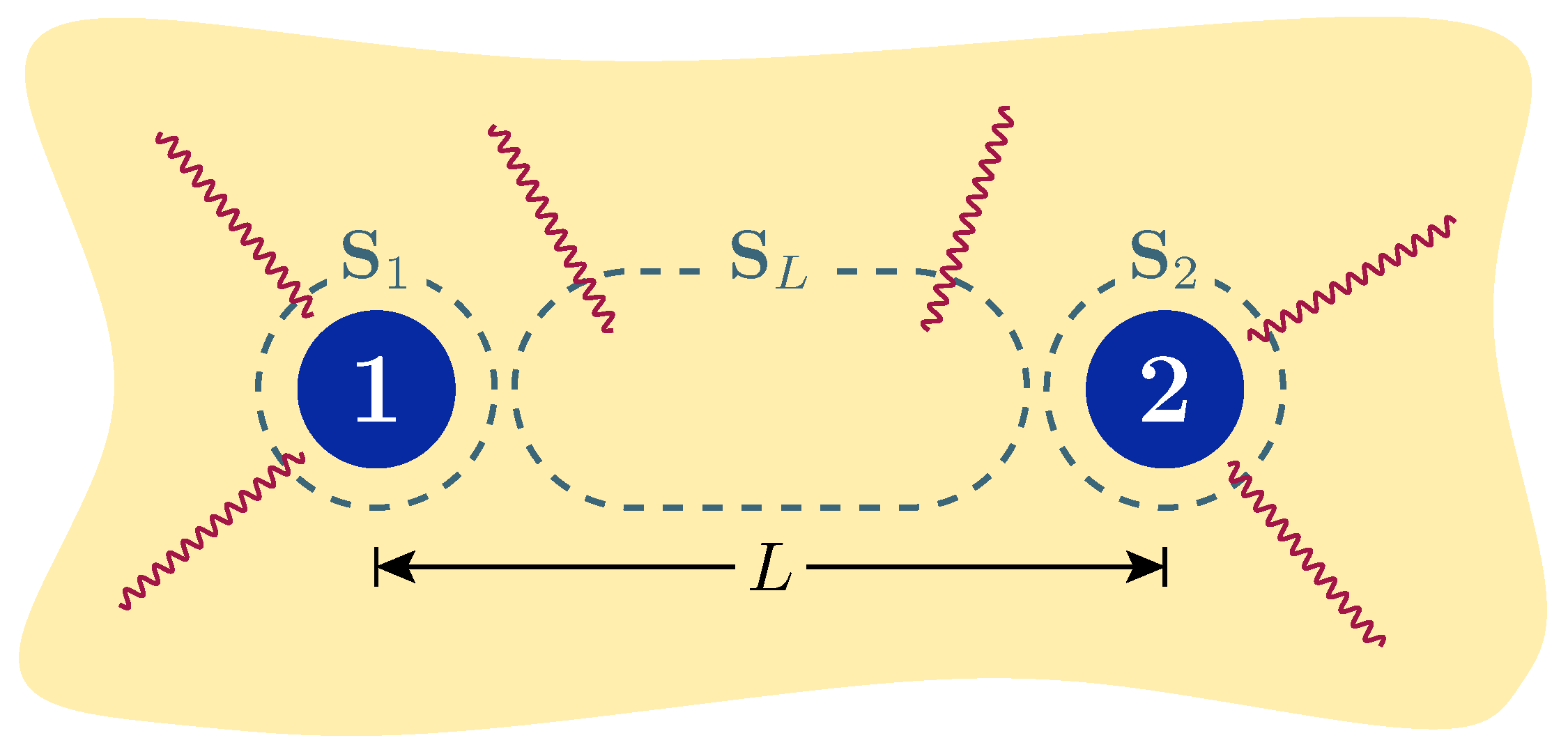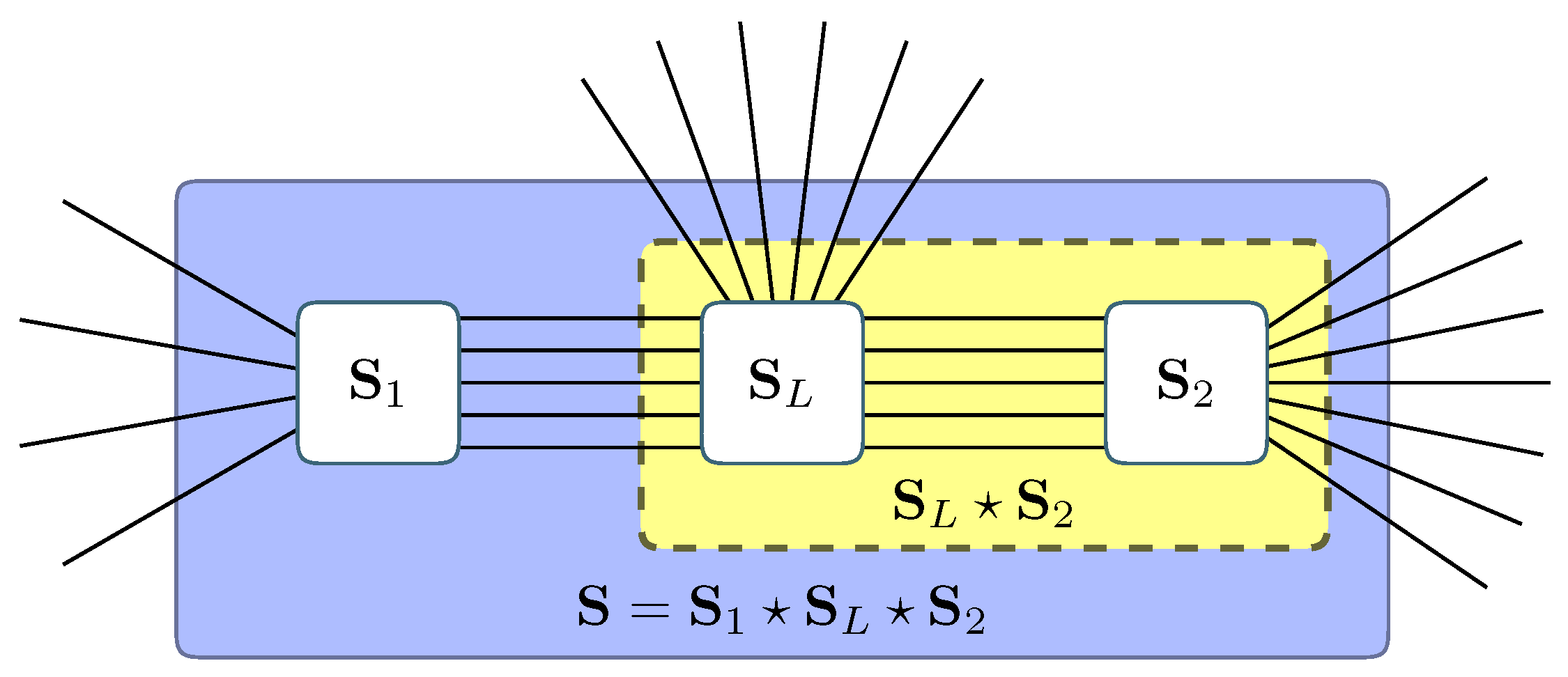Accounting for Dissipation in the Scattering Approach to the Casimir Energy
Abstract
:1. Introduction
2. Scattering Interpretation of the Casimir Effect
3. Determinant Formula for Two Scatterers
4. Application to the Casimir Interaction Energy
5. Conclusions
Author Contributions
Conflicts of Interest
Appendix A. Useful Lemmas
References
- Casimir, H.B.G. On the attraction between two perfectly conducting plates. Proc. K. Ned. Akad. Wet. 1948, 51, 793–796. [Google Scholar]
- Lifshitz, E.M. The theory of molecular attractive forces between solids. Sov. Phys. JETP 1956, 2, 73–83. [Google Scholar]
- Schwinger, J.; DeRaad, L.L.; Milton, K.A. Casimir effect in dielectrics. Ann. Phys. 1978, 115, 1–23. [Google Scholar] [CrossRef]
- Decca, R.S.; López, D.; Fischbach, E.; Klimchitskaya, G.L.; Krause, D.E.; Mostepanenko, V.M. Precise comparison of theory and new experiment for the Casimir force leads to stronger constraints on thermal quantum effects and long-range interactions. Ann. Phys. 2005, 318, 37–80. [Google Scholar] [CrossRef]
- Decca, R.S.; López, D.; Fischbach, E.; Klimchitskaya, G.L.; Krause, D.E.; Mostepanenko, V.M. Tests of new physics from precise measurements of the Casimir pressure between two gold-coated plates. Phys. Rev. D 2007, 75, 077101. [Google Scholar] [CrossRef] [Green Version]
- Masuda, M.; Sasaki, M. Limits on nonstandard forces in the submicrometer range. Phys. Rev. Lett. 2009, 102, 171101. [Google Scholar] [CrossRef] [PubMed]
- Sushkov, A.O.; Kim, W.J.; Dalvit, D.A.R.; Lamoreaux, S.K. New experimental limits on non-Newtonian forces in the micrometer range. Phys. Rev. Lett. 2011, 107, 171101. [Google Scholar] [CrossRef] [PubMed]
- Chang, C.-C.; Banishev, A.A.; Castillo-Garza, R.; Klimchitskaya, G.L.; Mostepanenko, V.M.; Mohideen, U. Gradient of the Casimir force between Au surfaces of a sphere and a plate measured using an atomic force microscope in a frequency-shift technique. Phys. Rev. B 2012, 85, 165443. [Google Scholar] [CrossRef]
- Lambrecht, A.; Reynaud, S. Casimir force between metallic mirrors. Eur. Phys. J. D 2000, 8, 309–318. [Google Scholar] [CrossRef]
- Boström, M.; Sernelius, B.E. Thermal effects on the Casimir force in the 0.1–5 μm range. Phys. Rev. Lett. 2000, 84, 4757–4760. [Google Scholar] [CrossRef] [PubMed]
- Milton, K.A. Recent developments in the Casimir effect. J. Phys. Conf. Ser. 2009, 161, 012001. [Google Scholar] [CrossRef]
- Rahi, S.J.; Emig, T.; Graham, N.; Jaffe, R.L.; Kardar, M. Scattering theory approach to electrodynamic Casimir forces. Phys. Rev. D 2009, 80, 085021. [Google Scholar] [CrossRef]
- Klimchitskaya, G.L.; Mohideen, U.; Mostepanenko, V.M. The Casimir force between real materials: Experiment and theory. Rev. Mod. Phys. 2009, 81, 1827–1885. [Google Scholar] [CrossRef]
- Ingold, G.-L.; Lambrecht, A.; Reynaud, S. Quantum dissipative Brownian motion and the Casimir effect. Phys. Rev. E 2009, 80, 041113. [Google Scholar] [CrossRef] [PubMed]
- Reynaud, S.; Lambrecht, A. Casimir Forces and Vacuum Energy. In Quantum Optics and Nanophotonics; Lecture Notes of the Les Houches Summer School 101; Fabre, C., Sandoghdar, V., Treps, N., Cugliandolo, L.F., Eds.; Oxford University Press: Oxford, UK, 2017; pp. 407–455. [Google Scholar] [CrossRef]
- Naji, A.; Dean, D.S.; Sarabadani, J.; Horgan, R.R.; Podgornik, R. Fluctuation-induced interaction between randomly charged dielectrics. Phys. Rev. Lett. 2010, 104, 060601. [Google Scholar] [CrossRef] [PubMed]
- Speake, C.C.; Trenkel, C. Forces between conducting surfaces due to spatial variations of surface potential. Phys. Rev. Lett. 2003, 90, 160403. [Google Scholar] [CrossRef] [PubMed]
- Kim, W.J.; Sushkov, A.O.; Dalvit, D.A.R.; Lamoreaux, S.K. Surface contact potential patches and Casimir force measurements. Phys. Rev. A 2010, 81, 022505. [Google Scholar] [CrossRef]
- Behunin, R.O.; Intravaia, F.; Dalvit, D.A.R.; Maia Neto, P.A.; Reynaud, S. Modeling electrostatic patch effects in Casimir force measurements. Phys. Rev. A 2012, 85, 012504. [Google Scholar] [CrossRef]
- Behunin, R.O.; Zeng, Y.; Dalvit, D.A.R.; Reynaud, S. Electrostatic patch effects in Casimir-force experiments performed in the sphere-plane geometry. Phys. Rev. A 2012, 86, 052509. [Google Scholar] [CrossRef]
- Behunin, R.O.; Dalvit, D.A.R.; Decca, R.S.; Genet, C.; Jung, I.W.; Lambrecht, A.; Liscio, A.; López, D.; Reynaud, S.; Schnoering, G.; et al. Kelvin probe force microscopy of metallic surfaces used in Casimir force measurements. Phys. Rev. A 2014, 90, 062115. [Google Scholar] [CrossRef]
- Intravaia, F.; Henkel, C. Casimir interaction from magnetically coupled eddy currents. Phys. Rev. Lett. 2009, 103, 130405. [Google Scholar] [CrossRef] [PubMed]
- Guérout, R.; Lambrecht, A.; Milton, K.A.; Reynaud, S. Derivation of the Lifshitz-Matsubara sum formula for the Casimir pressure between metallic plane mirrors. Phys. Rev. E 2014, 90, 042125. [Google Scholar] [CrossRef] [PubMed]
- Guérout, R.; Lambrecht, A.; Milton, K.A.; Reynaud, S. Lifshitz-Matsubara sum formula for the Casimir pressure between magnetic metallic mirrors. Phys. Rev. E 2016, 93, 022108. [Google Scholar] [CrossRef] [PubMed]
- Barash, Y.S.; Ginzburg, V.L. Electromagnetic fluctuations in matter and molecular (van der Waals) forces between them. Sov. Phys. Usp. 1975, 18, 305–322. [Google Scholar] [CrossRef]
- Bordag, M. Drude model and Lifshitz formula. Eur. Phys. J. C 2011, 71, 1788. [Google Scholar] [CrossRef]
- Jancovici, B.; Šamaj, L. Casimir force between two ideal-conductor walls revisited. Europhys. Lett. 2005, 72, 35–41. [Google Scholar] [CrossRef]
- Buenzli, P.R.; Martin, P.A. The Casimir force at high temperature. Europhys. Lett. 2005, 72, 42–48. [Google Scholar] [CrossRef]
- Intravaia, F.; Behunin, R. Casimir effect as a sum over modes in dissipative systems. Phys. Rev. A 2012, 86, 062517. [Google Scholar] [CrossRef]
- Bordag, M. Casimir and Casimir-Polder forces with dissipation from first principles. Phys. Rev. A 2017, 96, 062504. [Google Scholar] [CrossRef]
- Jaekel, M.T.; Reynaud, S. Casimir force between partially transmitting mirrors. J. Phys. I France 1991, 1, 1395–1409. [Google Scholar] [CrossRef]
- Ingold, G.-L.; Lambrecht, A. Casimir effect from a scattering approach. Am. J. Phys. 2015, 83, 156–162. [Google Scholar] [CrossRef]
- Genet, C.; Lambrecht, A.; Reynaud, S. Casimir force and the quantum theory of lossy optical cavities. Phys. Rev. A 2003, 67, 043811. [Google Scholar] [CrossRef]
- Lambrecht, A.; Maia Neto, P.A.; Reynaud, S. The Casimir effect within scattering theory. New J. Phys. 2006, 8, 243. [Google Scholar] [CrossRef]
- Engquist, H.L.; Anderson, P.W. Definition and measurement of the electrical and thermal resistances. Phys. Rev. B 1981, 24, 1151–1154. [Google Scholar] [CrossRef]
- Huttner, B.; Barnett, S.M. Quantization of the electromagnetic-field in dielectrics. Phys. Rev. A 1992, 46, 4306–4322. [Google Scholar] [CrossRef] [PubMed]
- Matloob, R.; Loudon, R.; Barnett, S.M.; Jeffers, J. Electromagnetic field quantization in absorbing dielectrics. Phys. Rev. A 1995, 52, 4823–4838. [Google Scholar] [CrossRef] [PubMed]
- Schwinger, J. The theory of quantized fields. VI. Phys. Rev. 1954, 94, 1362–1384. [Google Scholar] [CrossRef]
- Balian, R.; Duplantier, B. Electromagnetic waves near perfect conductors. I. Multiple scattering expansions. Distribution of modes. Ann. Phys. 1977, 104, 300–335. [Google Scholar] [CrossRef]
- Plunien, G.; Müller, B.; Greiner, W. The Casimir effect. Phys. Rep. 1986, 134, 87–193. [Google Scholar] [CrossRef]
- Souma, S.; Suzuki, A. Local density of states and scattering matrix in quasi-one-dimensional systems. Phys. Rev. B 2002, 65, 115307. [Google Scholar] [CrossRef]
- Dzyaloshinskii, I.E.; Lifshitz, E.M.; Pitaevskii, L.P. General theory of van der Waals’ forces. Sov. Phys. Usp. 1961, 4, 153–176. [Google Scholar] [CrossRef]
- Wittmann, R.C. Spherical wave operators and the translation formulas. IEEE Trans. Antennas Propag. 1988, 36, 1078–1087. [Google Scholar] [CrossRef]
- Guérout, R.; Lussange, J.; Chan, H.B.; Lambrecht, A.; Reynaud, S. Thermal Casimir force between nanostructured surfaces. Phys. Rev. A 2013, 87, 052514. [Google Scholar] [CrossRef]
- Cherroret, N.; Crépin, P.-P.; Guérout, R.; Lambrecht, A. Casimir-Polder force fluctuations as spatial probes of dissipation in metals. EPL 2017, 117, 63001. [Google Scholar] [CrossRef]
- Lambrecht, A.; Jaekel, M.-T.; Reynaud, S. Motion induced radiation from a vibrating cavity. Phys. Rev. Lett. 1996, 77, 615–618. [Google Scholar] [CrossRef] [PubMed]
- Maghrebi, M.F.; Golestanian, R.; Kardar, M. Scattering approach to the dynamical Casimir effect. Phys. Rev. D 2013, 87, 025016. [Google Scholar] [CrossRef]
- Wilson, C.M.; Johansson, G.; Pourkabirian, A.; Simoen, M.; Johansson, J.R.; Duty, T.; Nori, F.; Delsing, P. Observation of the dynamical Casimir effect in a superconducting circuit. Nature 2011, 479, 376–379. [Google Scholar] [CrossRef] [PubMed]
- Felicetti, S.; Sanz, M.; Lamata, L.; Romero, G.; Johansson, G.; Delsing, P.; Solano, E. Dynamical Casimir effect entangles artificial atoms. Phys. Rev. Lett. 2014, 113, 093602. [Google Scholar] [CrossRef] [PubMed]




© 2018 by the authors. Licensee MDPI, Basel, Switzerland. This article is an open access article distributed under the terms and conditions of the Creative Commons Attribution (CC BY) license (http://creativecommons.org/licenses/by/4.0/).
Share and Cite
Guérout, R.; Ingold, G.-L.; Lambrecht, A.; Reynaud, S. Accounting for Dissipation in the Scattering Approach to the Casimir Energy. Symmetry 2018, 10, 37. https://doi.org/10.3390/sym10020037
Guérout R, Ingold G-L, Lambrecht A, Reynaud S. Accounting for Dissipation in the Scattering Approach to the Casimir Energy. Symmetry. 2018; 10(2):37. https://doi.org/10.3390/sym10020037
Chicago/Turabian StyleGuérout, Romain, Gert-Ludwig Ingold, Astrid Lambrecht, and Serge Reynaud. 2018. "Accounting for Dissipation in the Scattering Approach to the Casimir Energy" Symmetry 10, no. 2: 37. https://doi.org/10.3390/sym10020037




